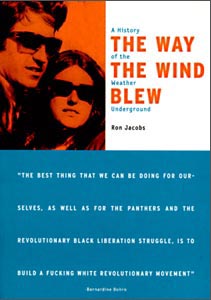Stormy Weather
A new history of the Weatherman still founders in ideology
By Ralph Seliger
ALTHOUGH IT IS A rather skimpy history of youthful radicalism from the late '60s into the early '80s, Ron Jacobs' The Way the Wind Blew: A History of the Weather Underground does recapture the ferocity of those times: the "Days of Rage" in Chicago in October 1969, the National Mobilization to End the War in November 1969, the May 1970 killings of student demonstrators at Kent State and Jackson State universities, police shootouts with the Black Panthers, massive demonstrations, bomb attacks and political manifestos.
Author Jacobs, who now works at the University of Vermont and writes for the alternative monthly Works in Progress, was a U.S. Army brat in high school in Germany when the Weatherman (or Weather) faction emerged from Students for a Democratic Society in June 1969. (At that same time, I was attending the final national convention of the SDS, held in a rundown Chicago meeting center, gathering material for an undergraduate thesis in political science.) His jargon-laden rhetorical style and complete identification with the general ideological premises of his subjects illustrate the polarized tenor of those years.
Jacobs would agree with most of the following: The creation of the Revolutionary Youth Movement (RYM), as the Weather faction was first called, was a reaction to the growing influence of the rigidly Stalinist-Maoist Progressive Labor Party in SDS chapters.
The strategy of the SDS national office was to attack the PLP from the left by jumping toward a hyper-revolutionary stance in support of embattled Third World forces epitomized in the U.S. by the Black Panther Party and abroad by the Vietcong/National Liberation Front and the North Vietnamese.
The PLP advocated a more conventional Marxist orientation--organizing the blue-collar working class. It also criticized the Black Panthers for nationalism and racial posturing that alienated their potential white working-class allies.
Jacobs, however, would not be troubled by the fact that the PLP was slurred as racist and counterrevolutionary for daring to criticize Third World revolutionaries--rather than attacked as a Stalinist authoritarian threat.
In the hypermilitant environment of the New Left at that time--brought about by the seemingly endless war in Indochina and other, Nixon-era outrages--the worst adaptations of "revolutionary" or Marxist theory and practice had widespread appeal. Jacobs documents, but neither notes nor laments, the fact that the new left, which had emerged in the early '60s with so much promise as a fresh direction inspired by the civil rights movement, ended up burying itself in old-left sectarianism.
Seeing the June 1969 convention pass to Progressive Labor Party control, the SDS National Office faction feverishly caucused in an adjoining chamber. They emerged hours later into a deafening confrontation of chants and counterchants before exiting into the night with fists clenched in defiance. Jacobs entirely sides with this nascent Weather group, even parroting the line that its retreat from the hall amounted to an expulsion of the PLP and that its brief effort to function as a rump SDS somehow had legitimacy.
JACOBS FOLLOWS THE Weathermen to their December 1969 "war council" in Flint, Mich., at which the "Weatherbureau" decided behind closed doors to go underground and fashion a fighting organization in support of Third World revolution. Weather extolled the revolutionary virtues of crime and violence, and Bernardine Dohrn infamously praised the Manson family for the Tate-La Bianca murders.
Jacobs depicts the underground life of the Weathermen mostly in episodic fashion. There are references to the directed use of drugs and sex as means of maintaining political loyalty and group cohesion, but this very human side of the Weather experience is not explored in any depth.
Jacobs' description of the last Weather-related group event, the Hard Times conference in Chicago 1976, is hopelessly muddled with fleeting references to fierce arguments regarding class, racial and gender issues. Apparently, this event persuaded one faction of Weather, the Bay Area Revolutionary Committee, to "expel" the New York-based Central Committee faction for reformist tendencies.
Amid all this wrangling, it is unclear where the author stands. Apart from ultraleftist pronouncements, he appears incapable of critical judgment. Jacobs takes no clue from the facts he documents that because Weather went out with a whimper and not a bang, "Amerika," for all its faults, was not fascist.
The Weatherpeople who began to emerge from hiding to surrender, starting with Mark Rudd in September 1977 and for more than a decade after, were mostly just slapped on the wrist. Rudd received a $2,000 fine and two years' probation; Dohrn got three years' probation and a $1,500 fine. Others were similarly sentenced. Only those convicted in a Brinks holdup in 1981, in which two policemen were killed, have been sentenced to long prison terms. And more than once, reference is made to defendants being released by courts because of illegally obtained evidence.
The author provides precious little detail on the post-Weather lives and views of the activists. His readers would be totally unprepared for the current perspective of no less a figure than Bill Ayers--a Weather founder, now married to Dohrn. Speaking in Chicago last summer at Michael Lerner's "Summit for Ethics and Meaning," Ayers demanded that we not "romanticize the '60s. It's time to put them behind us." But Ron Jacobs remains warped in time--and vision.
[ San Jose | Metroactive Central | Archives ]
Copyright © Metro Publishing Inc. Maintained by Boulevards New Media.
![]()

The Way the Wind Blew: A History of the Weather Underground
By Ron Jacobs
Verso; 216 pages; $15 paper/$50 cloth
Ralph Seliger observed the birth of Weather at the SDS convention in Chicago in 1969. He writes from New York for a variety of publications.
From the February 26-March 4, 1998 issue of Metro.
![[Metroactive Books]](/books/gifs/books468.gif)